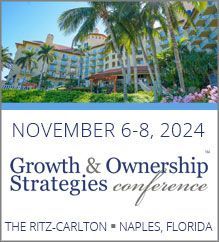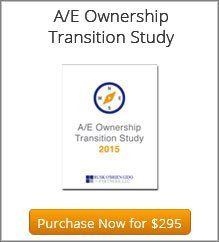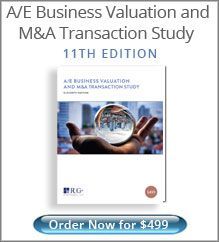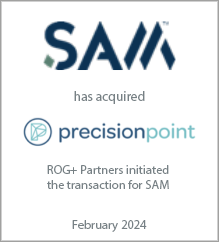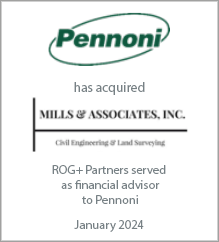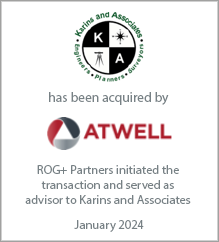Ian has spent the past twenty years working with hundreds of architecture, engineering and environmental consulting firms large and small throughout the U.S. and abroad with a focus on ownership planning, business valuation, ESOP advisory services, mergers & acquisitions, and strategic planning. Ian is a professionally trained and accredited business appraiser and holds the Accredited Senior Appraiser (ASA) designation with the American Society of Appraisers and is a certified merger & acquisition advisor (CM&AA) with the Alliance of Merger & Acquisition Advisors.
Small Firms Face Unique Ownership Transition Challenges
Small Firms Face Unique Ownership Transition Challenges
September 6, 2012
Planning for ownership transition is a challenge in any firm, but for small firms, sometimes it can seem like the deck is stacked against you. Imagine this: You’re the founder and majority owner of a 35-person civil engineering firm. You’re 62 years old, and while you still enjoy what you do, it doesn’t feel quite so fun anymore. The recession set you back four or five years in terms of your revenue and staff levels, and unfortunately, that included the loss of two key managers. You had envisioned an internal ownership transition that would involve your next tier of managers, but now those ranks have dwindled, as has their enthusiasm for buying stock.
So what do you do now? Is it possible to resuscitate your internal ownership transition plan? Would a strategic buyer (a larger A/E firm) be interested in a small firm like yours? Maybe an employee stock ownership plan (ESOP) would be the way to go, but is your firm big enough?
This is the dilemma many small firm owners are facing right now. Unfortunately, there are many misperceptions and no small amount of misinformation out there when it comes to ownership transition strategies. Here are some common misperceptions and our own attempt to “fact-check” them.
“We’re too Small a Morsel for the Serial Buyers”
It’s the big deals that often make the headlines, like AMEC’s acquisition of Mactec, or CDM’s purchase of Wilbur Smith. But for every headline-making mega-merger, there are scores of small transactions, including acquisitions of firms of ten or fewer employees. In fact, of the 170 or so transactions in the architecture, engineering and environmental consulting industry so far in 2012, the median staff size of the selling firm has been just 30 employees.
The key for a small firm is having some unique value to bring to a strategic buyer, like access to a niche market, a specialty service, or strong relationships with “blue chip” clients. Take the recent example of Perkins+Will’s acquisition of 15-person Envision Design in Washington, DC. In its August 13th press release, Perkins+Will cited Envision’s market leading position in sustainable design and listed its many high profile clients and numerous design awards.
Unfortunately, the days of firms making acquisitions just to add bodies are over. If you’re a small firm considering a sale to a strategic buyer, you must first identify those unique benefits you would bring to a buyer then identify the buyers that would benefit the most by acquiring your firm.
“We’re not big enough to sponsor an ESOP”
While ESOPs have a certain level of fixed costs that are easier for larger firms to manage, you don’t need to have 100 or more employees to make an ESOP work. In fact, a recent study by the National Center for Employee Ownership (Oakland, CA) indicates that 38% of the 10,900 ESOP companies in the U.S. have 50 or fewer employees. As the chart below indicates, ESOP companies are most heavily represented by small firms. And in case you were wondering, the A/E sector is among the four most common industries represented by ESOP companies.
So what do you do now? Is it possible to resuscitate your internal ownership transition plan? Would a strategic buyer (a larger A/E firm) be interested in a small firm like yours? Maybe an employee stock ownership plan (ESOP) would be the way to go, but is your firm big enough?
This is the dilemma many small firm owners are facing right now. Unfortunately, there are many misperceptions and no small amount of misinformation out there when it comes to ownership transition strategies. Here are some common misperceptions and our own attempt to “fact-check” them.
“We’re too Small a Morsel for the Serial Buyers”
It’s the big deals that often make the headlines, like AMEC’s acquisition of Mactec, or CDM’s purchase of Wilbur Smith. But for every headline-making mega-merger, there are scores of small transactions, including acquisitions of firms of ten or fewer employees. In fact, of the 170 or so transactions in the architecture, engineering and environmental consulting industry so far in 2012, the median staff size of the selling firm has been just 30 employees.
The key for a small firm is having some unique value to bring to a strategic buyer, like access to a niche market, a specialty service, or strong relationships with “blue chip” clients. Take the recent example of Perkins+Will’s acquisition of 15-person Envision Design in Washington, DC. In its August 13th press release, Perkins+Will cited Envision’s market leading position in sustainable design and listed its many high profile clients and numerous design awards.
Unfortunately, the days of firms making acquisitions just to add bodies are over. If you’re a small firm considering a sale to a strategic buyer, you must first identify those unique benefits you would bring to a buyer then identify the buyers that would benefit the most by acquiring your firm.
“We’re not big enough to sponsor an ESOP”
While ESOPs have a certain level of fixed costs that are easier for larger firms to manage, you don’t need to have 100 or more employees to make an ESOP work. In fact, a recent study by the National Center for Employee Ownership (Oakland, CA) indicates that 38% of the 10,900 ESOP companies in the U.S. have 50 or fewer employees. As the chart below indicates, ESOP companies are most heavily represented by small firms. And in case you were wondering, the A/E sector is among the four most common industries represented by ESOP companies.
Source: National Center for Employee Ownership
There are other considerations as well. Company culture, management structure, and corporate governance structure are all factors to consider. Generally speaking, firms that practice open book management and promote employee participation in management are better suited for ESOP ownership than those that do not. So don’t let your firm’s size be the only factor in considering an ESOP as part of your ownership transition plan. A feasibility analysis prepared by a qualified financial advisor is the only real way to tell if your firm is financially capable of sponsoring an ESOP.
“We just don’t have the next generation of leaders needed for an internal transition”
This is an increasingly common refrain among owners in our industry. Small firms by definition have a smaller pool of leadership candidates to begin with, so they often feel this constraint much more acutely. Compounding this is the tendency of small firm owners to hoard management responsibilities and even client relationships, rather than training the next generation in business management and business development.
There’s also a tendency among some baby-boomer owners to fail to recognize the potential of the younger generations within their firm. Let’s face it; owners in this sector are a rather homogenous bunch of 50-somethings, and often they look (unsuccessfully) for their successors to be carbon copies of themselves. Generations X and Y may think and work in different ways than baby-boomers, but that doesn’t make them unfit to lead. For proof of this, just look outside of our industry; CEOs under 40 years old abound in the technology and internet sectors (think Larry Page of Google).
Owners of small firms (or any size firms for that matter) would benefit by re-examining their pre-conceived notions of what qualifies an employee to be an ownership candidate. Must every owner be a licensed professional? Must they have a certain number of years of experience or tenure? Cast a wider net and you might be surprised to find more leadership potential in your small firm than you first believed.
Conclusion
Yes, the ownership transition journey is often a tougher one for smaller firms, but virtually all the paths available to larger firms are also available to smaller ones. For small firm owners, a successful transition simply requires more careful and thoughtful planning.
There are other considerations as well. Company culture, management structure, and corporate governance structure are all factors to consider. Generally speaking, firms that practice open book management and promote employee participation in management are better suited for ESOP ownership than those that do not. So don’t let your firm’s size be the only factor in considering an ESOP as part of your ownership transition plan. A feasibility analysis prepared by a qualified financial advisor is the only real way to tell if your firm is financially capable of sponsoring an ESOP.
“We just don’t have the next generation of leaders needed for an internal transition”
This is an increasingly common refrain among owners in our industry. Small firms by definition have a smaller pool of leadership candidates to begin with, so they often feel this constraint much more acutely. Compounding this is the tendency of small firm owners to hoard management responsibilities and even client relationships, rather than training the next generation in business management and business development.
There’s also a tendency among some baby-boomer owners to fail to recognize the potential of the younger generations within their firm. Let’s face it; owners in this sector are a rather homogenous bunch of 50-somethings, and often they look (unsuccessfully) for their successors to be carbon copies of themselves. Generations X and Y may think and work in different ways than baby-boomers, but that doesn’t make them unfit to lead. For proof of this, just look outside of our industry; CEOs under 40 years old abound in the technology and internet sectors (think Larry Page of Google).
Owners of small firms (or any size firms for that matter) would benefit by re-examining their pre-conceived notions of what qualifies an employee to be an ownership candidate. Must every owner be a licensed professional? Must they have a certain number of years of experience or tenure? Cast a wider net and you might be surprised to find more leadership potential in your small firm than you first believed.
Conclusion
Yes, the ownership transition journey is often a tougher one for smaller firms, but virtually all the paths available to larger firms are also available to smaller ones. For small firm owners, a successful transition simply requires more careful and thoughtful planning.
Latest Perspective
Perfecting the A/E Exit Strategy – Five Key Factors
An enormous A/E generation that kicked off their careers in the 1980s and subsequently started firms or became owners in the 1990s ...
© 2024
Rusk O'Brien Gido + Partners, LLC
Financial Experts for Architects, Engineers, and Environmental Consulting Firms



